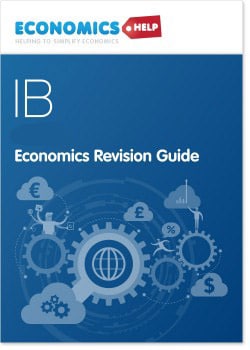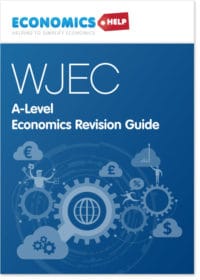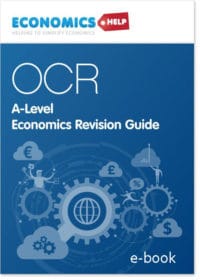IB Economics revision guide
£8.95
- Specific IB Economics revision guide (Sections1,2,3,4) – just £8.95
- Updated for current IB Economics syllabus
- E-book (comes in pdf format shortly after purchase.)
- Trademark simplicity and clarity of presentation.
- Significantly expanded on the previous version, with not just required knowledge, but also examples of evaluation for each topic.
- For schools: Network License – IB Economics (£95.00) (allowing unlimited use)
- Sample (3 pages) IB Revision Guide
Description
- Recently updated and expanded
- It is designed specifically for IB economics.
IB economics revision guide (E-Book)
- Simple yet detailed.
- Content designed to help prepare for likely questions.
- All main diagrams needed for IB Economics
- Tips on writing evaluation – Essential for getting top grades
- Updated: 2015.
- Revision guide sent shortly after purchase.
Syllabus – Micro economics Section 1
- Foundations of economics
- Economic models
- Positive economic statements
- Rational decision making
- Scarcity
- Choice and opportunity cost
- Production possibility frontiers (PPF)
- Possibility frontier and economic growth
- Markets
- Demand
- Shifts in the demand curve
- Linear demand curve (HL)
- Supply
- Shifts in the supply curve
- Linear supply curve (HL)
- Market equilibrium
- Calculating equilibrium using linear equations (HL)
- Allocation of resources
- Consumer surplus
- Producer surplus
- Elasticity
- Using knowledge of elasticity
- The impact of elasticity on tax
- Income elasticity of demand (YED)
- Cross elasticity of demand
- Price elasticity of supply
- Tax
- Reasons for tax
- Tax and linear supply curves (HL)
- Subsidy
- Price controls
- Maximum prices
- Minimum prices
- Market failure
- Externalities and social efficiency
- Negative externality
- Positive externality
- Private good
- Public good
- Merit good
- Demerit good
- Common access resources
- Policies to overcome market failure
- Tax
- Cap and trade
- Monopoly power
- Theory of the firm and market structures (HL)
- Costs of production
- Law of diminishing returns
- Economies of scale
- Diseconomies of scale
- Revenue
- Profit
- Whether a firm will produce
- Profit maximisation
- Business objectives
- Perfect competition
- Types of efficiency
- Monopoly
- Barriers to entry
- Revenue maximisation and elasticity
- Monopolistic competition
- Oligopoly
- The kinked demand curve
- Game theory and the prisoner’s dilemma
- Collusive behaviour
- Price discrimination
- Application of theory: Principles of economics
- Application of knowledge – environment
- Application of knowledge: business economics
Unit 2 Macroeconomics
- Circular flow of income
- Measuring national income
- Gross domestic product GDP, GNP, GNI (HL)
- GDP as a measure of living standards
- Economic cycle
- Aggregate demand
- Consumer spending (C)
- Investment (I)
- Government expenditure (G)
- Net trade (X-M)
- Accelerator effect
- Aggregate supply (AS)
- Short-run aggregate supply SRAS
- Long-run aggregate supply (LRAS)
- Macroeconomic equilibrium
- Classical view of short-run growth
- Output gaps
- The Multiplier (HL)
- Unemployment
- Measuring unemployment
- Causes of unemployment
- The natural rate of unemployment
- Policies to reduce unemployment
- Inflation and deflation
- Calculating inflation (HL)
- Costs of inflation
- Problems of deflation
- Causes of deflation
- Causes of inflation
- Relationship between unemployment and inflation (HL)
- Economic growth
- Short-run economic growth
- Long-run economic growth
- Benefits of economic growth
- Potential costs of economic growth
- Poverty and inequality
- Measuring inequality
- Income deciles
- Poverty
- Income distribution and welfare
- Causes of income inequality
- Causes of wealth inequality
- Taxation
- Marginal and average tax rates (HL)
- Policies to reduce poverty
- Levels of government spending
- Government borrowing
- The National Debt
- Fiscal policy
- Expansionary fiscal policy
- Deflationary fiscal policy
- Monetary policy
- UK monetary policy
- Evaluation of monetary policy
- Quantitative easing
- Loanable funds theory
- Supply side policies
- Market-oriented supply-side policies
- Interventionist supply-side policies
- Evaluation of supply-side policies
Section 3: International economics
- Absolute and comparative advantage (HL)
- Example of trade (HL)
- Restrictions on free trade
- The effects of tariffs (HL)
- The effect of quotas
- Benefits of free trade
- Arguments for restricting trade
- WTO
- Exchange rates
- Factors that influence exchange rates
- Managed exchange rates (Managed float)
- Appreciation in the exchange rate
- Evaluation of an appreciation
- The balance of payments
- Current account
- Factors that cause a current account deficit
- Policies to reduce a balance of payments deficit
- Current account surplus (HL)
- Economic integration
- Forms of integration
- Monetary Union
- Terms of trade (HL)
- Factor influencing terms of trade (HL)
- Effect of deterioration in terms of trade (HL)
Section 4: Development economics
- Measuring economic development
- Human development index (HDI)
- Relationship between economic growth and development
- Characteristics of LEDCs
- Poverty cycle
- United Nations Millennium Development Goals
- Trade problems faced by less developed economies
- Foreign debt
- Strategies to promote growth and development
Additional information
| License |
|---|





